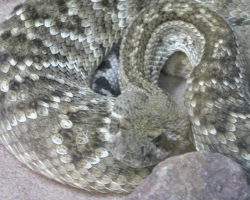
Approximately 300,000 dogs and cats are bitten by venomous snakes each year in the United States. That’s a lot of snake bites. A rattlesnake bite can be life-threatening to a dog, but not necessarily a death sentence. So what should one do if a dog is bitten?
The best way to keep a dog safe is to avoid snakes as much as possible and the places they like to hang out. That means using a leash and staying on a trail when hiking. Keep pups away from piles of rocks or leaves and never let them dig in holes on the path.
If a snake is encountered, remain calm (probably easier said than done), but having an action plan in place can help. According to the The American Society for the Prevention of Cruelty to Animals, “A rattlesnake can strike up to half the distance their length when coiled. If they are on a ledge or on higher ground, they can strike even longer distances. If you are in striking distance, get your dog to sit or remain still. The snake will try to get away from you, but if you are too close or make a lot of movement, they may strike at you or your dog in self-defense. If you feel you can back away cautiously, do so slowly without any sudden movements. If you are not in striking distance, turn around and move away from the snake. Let the snake clear the trail before continuing. If you can go around it on another path, then do so at a safe distance.”
I love taking my dog Gabby to Runyon Canyon, which is an off-leash dog trail, which is part of the fun for me and for her. So when hiking the trails I pay extra attention and never let her get off the well-worn path. Snakes typically find shade on sunny days and come out at dusk when the temperatures are cooler and when their prey is most active. Rattlesnakes are more active in the spring, when they first come out of hibernation, and in the late summer and early fall, when they breed. It’s good to keep this in mind when choosing a time of day to hike.
If a rattlesnake bites your dog, get it to a veterinarian as soon as possible. Small dogs may react faster to the venom than larger dogs. If the dog is too heavy to carry, that could be a problem. Dogs can go into shock within minutes of a rattlesnake bite. If there are two adults, a towel or blanket can be used as a sling to carry the dog back to the car. Do not cut the dog and try to suck out the poison. Do not put ice on the wound, either – it could damage the tissue around the bite area. Use soap and water to clean the wound.
For anyone who does a lot of outdoor activities with their pups in the summer, consider investigating trainers who can teach dogs to avoid rattlesnakes and consider carrying a rattlesnake vaccine. Choose a trainer with a reputation for humane training techniques. Be involved in the training to learn what to do when encountering a snake.
According to the PetEducation.com, “There is a rattlesnake vaccine that helps your dog to develop antibodies that will help prevent an allergic reaction to the bite of a Western diamondback rattler. The venom of other venomous snakes in the United States is similar to the venom of the Western diamondback. Dogs that are vaccinated have less pain, less swelling, less tissue damage and recover faster when bitten by a rattlesnake than dogs that are not vaccinated. Even if your dog is vaccinated, a rattlesnake bite still needs medical attention.”
Enjoy Mother Nature, but remember to be safe, have a game plan and try not to panic if a rattlesnake bites. Happy trails.
